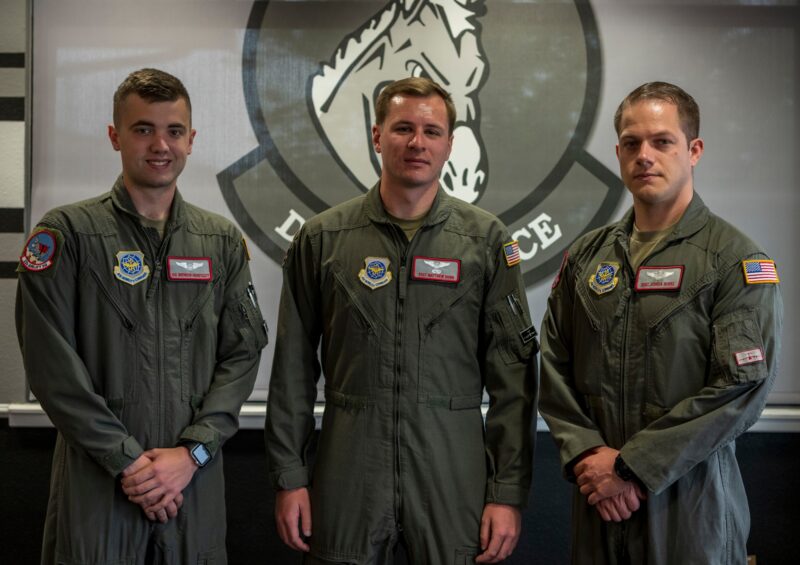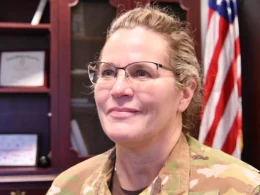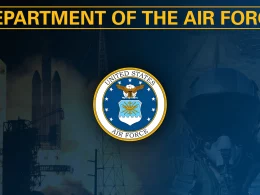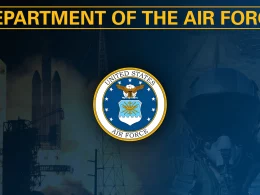TRAVIS AIR FORCE BASE, Calif. – It’s dusk. You’re sitting in chairs at a scenic overlook with two of your Wingmen to watch the sunset from Mount Tamalpias, Muir Woods, California. It is a quiet evening, April 29th, 2023.
As you sit and think of your career, your week, the forest air relaxing you for an event-filled weekend of camping, hiking and late nights under a blanket of stars … and then suddenly, a car comes flying around the corner of a sharp mountain road – the car becomes airborne – it is gone in a flash down in to the ravine – what do you do?
“I cannot believe that just happened,” were the words that escaped the mouth of U.S. Air Force Staff Sgt. Matthew Dunn, 22nd Airlift Squadron C-5M Super Galaxy flight engineer.
Dunn confirmed with the other two, Staff Sgt. Joshua Burke and Airman 1st Class Brendon Honeycutt, also flight engineers in the 22nd AS.
The trio was out in the woods attempting to spend the weekend exploring. But this car flying off the cliff changed everything.
“Were people in there?” Honeycutt remembers saying to the other two as well as a few other onlookers parked at the overlook.
The trio of engineers decided there was only one thing they could do, help whomever was in that car. The three set off toward the ravine.
Burke and Honeycutt were the first to descend the steep, 500-foot trek down the mountainside. Dunn followed suit shortly after making contact with 911 and rescue crews. The hill consisted of loose material going down, so the trio were very cautious while attempting to rescue whomever was in that car.
“You couldn’t see the car from where it launched,” Dunn said. “The only way we found the car is because we could smell the gas and the car was down in the ravine.”
As the odor of gasoline quickly overcame the mountain air, the engineers found themselves in a real scenario and their Air Force training kicked in. The trio are aircrew and have completed a large number of different trainings like Tactical Care Training and Survival school, which they said helped more with the stressfulness of the situation.
Once arriving to the vehicle, to their shock, the driver was still alive. The first thing they did was look for any signs of a fire from the crash, or anything else that would put them in danger while attempting to rescue the driver.
“I was just trying to keep him awake,” Honeycutt said. “When you’re talking to someone who’s been injured the way he was, keeping him awake and talking was the most important thing – ‘stay awake, don’t go to sleep.’”
The man’s car settled nearly upside-down in a tree. The trio described the driver’s injuries as if the car had folded up on him like an accordion; his ankles were at his face, they said. The official report stated, ‘Major passenger space intrusion with the conscious driver entangled and extrication needed.’
As Dunn waved down the rescue helicopter, Burke and Honeycutt kept to the driver. They wanted to try and remove him but because of the possible spine injury, they chose not to.
Shortly after, a senior fire captain rappelled down the side of the mountain along with three other emergency personnel who roped down from the helicopter to the driver.
“These three Airmen functioned in a steep environment with hazards to themselves to check on the occupant and remained at scene,” said Aaron Jarvis, Marin County Fire Department senior fire chief. “These Airmen distinguished themselves with outstanding service by assisting my crew in an area they had no responsibility to act.”
The trio moved from being first on the scene to handing the support over to the rescue team so they were able to do what they needed to.
“Watching the medics do their job,” Dunn said, “Up-close and personal, it was impressive.”
The trio was able to relay information calmy and efficiently. Jarvis also leaned on the Airmen to help keep an eye on all of the rescue gear and hold a flashlight to illuminate the area while the rescue team continued their work.
“Anytime the rescue team was making a decision, they [the rescue personnel] were quick, short and sweet,” Burke said. “Truly fascinating to watch.”
Within a few moments of the man being freed from his vehicle and placed on a stretcher, the trio assisted carrying him to an open space. The individual on the stretcher was secured down in to a helicopter and gone.
“Once we opened the car and removed the driver, your Airmen helped us move the patient to an area better suited for a long line rescue from Sonoma County Sheriff’s Rescue Copter 10H1,” Jarvis said. “The patient was flown topside, transferred to ground ambulance and moved to the higher-level care helicopter REACH3 to be flown to a trauma center in the east bay.”
Then Jarvis turned his attention to these three Airmen.
“The senior fire captain asked who we were and what we were doing there, and he put two-and-two together pretty quickly that we were military,” Burke said.
Jarvis shared his appreciation for the Airmen with their leadership and the team was recognized formally in front of their squadron.
“I can’t thank these men enough for their actions,” Jarvis said. “They made a choice to do the right thing and had a duty to act when others stood by and watched. Additionally, they performed above and beyond by remaining with us, knowing their job was not complete until the patient was safely transferred.”
The trio said Jarvis thanked them for assisting, they said their farewells. Then the trio ascended back up the hill, but the long way up, in the dark and cold night – as they put it. The Airmen returned to their campsite, lit a fire – disbelief set in.
“Did we do the best we could?” the trio recalled thinking.
“Given the circumstances, it could’ve been way worse,” said Honeycutt. “I mean, this was a really bad situation for him, but I think because we were there, he was kept awake and responding and he left by helicopter breathing. We hope he made it.”
The trio wasn’t upset about missing the sunset, they were happier to learn something about themselves during the three-hour ordeal.
“It’s not often you get to see how you’ll react in a scenario like this,” Dunn said. “I’m proud of how we rallied and came together as a team to do something about it.”
While these Airmen spend a majority of their professional careers on the flightline, they were able to apply their basic first aid training and familiarity with high stress environments to provide initial support efforts. As flight engineers, these Airmen are trained to be able to inspect and operate the mechanical systems of their aircraft, which requires a vast amount of attention to detail to support the aircrew and complete a flight mission.
“I think because of our job, which can be high-stress,” Dunn said. “It helped because we were able to stay level-headed, react and do something.”
The man survived the accident and is recovering from his injuries.










